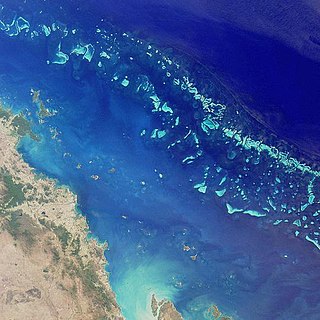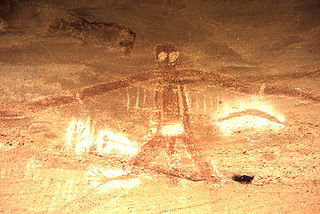Related Research Articles

Protected areas of Australia include Commonwealth and off-shore protected areas managed by the Australian government, as well as protected areas within each of the six states of Australia and two self-governing territories, the Australian Capital Territory and the Northern Territory, which are managed by the eight state and territory governments.
Native title refers to rights, recognised by Australian law, held by Aboriginal and Torres Strait Islander groups or individuals to land that derive from their maintenance of their traditional laws and customs. These Aboriginal title rights were first recognised as a part of Australian common law with the decision of Mabo v Queensland in 1992. The doctrine was subsequently implemented and modified via statute with the Native Title Act 1993.

The second question of the 1967 Australian referendum of 27 May 1967, called by the Holt government, related to Indigenous Australians. Voters were asked whether to give the Federal Government the power to make special laws for Indigenous Australians in states, and whether Indigenous Australians should be included in official population counts for constitutional purposes. The term "the Aboriginal Race" was used in the question.

Commonwealth v Tasmania was a significant Australian court case, decided in the High Court of Australia on 1 July 1983. The case was a landmark decision in Australian constitutional law, and was a significant moment in the history of conservation in Australia. The case centred on the proposed construction of a hydro-electric dam on the Gordon River in Tasmania, which was supported by the Tasmanian government, but opposed by the Australian federal government and environmental groups.
Australian archaeology is a large sub-field in the discipline of archaeology. Archaeology in Australia takes four main forms: Aboriginal archaeology, historical archaeology, maritime archaeology and the archaeology of the contemporary past. Bridging these sub-disciplines is the important concept of cultural heritage management, which encompasses Aboriginal and Torres Strait Islander sites, historical sites, and maritime sites.

The Australian National Heritage List or National Heritage List (NHL) is a heritage register, a list of national heritage places deemed to be of outstanding heritage significance to Australia, established in 2003. The list includes natural and historic places, including those of cultural significance to Indigenous Australians such as Aboriginal Australian sacred sites. Having been assessed against a set list of criteria, once a place is put on the National Heritage List, the provisions of the Environment Protection and Biodiversity Conservation Act 1999 apply.

Ngarrabullgan, officially named Mount Mulligan by the State, is a large tabletop mountain located 100 kilometres west of Cairns in the north of Queensland (Australia).

An Australian Aboriginal sacred site is a place deemed significant and meaningful by Aboriginal Australians based on their beliefs. It may include any feature in the landscape, and in coastal areas, these may lie underwater. The site's status is derived from an association with some aspect of social and cultural tradition, which is related to ancestral beings, collectively known as Dreamtime, who created both physical and social aspects of the world. The site may have its access restricted based on gender, clan or other Aboriginal grouping, or other factors.
The Aboriginal Cultural Heritage Act 2003 is legislation passed by Queensland Parliament, commencing in April 2004 to recognise, protect and conserve Aboriginal cultural heritage in the State of Queensland
The National Parks and Wildlife Act 1974 is the legislation passed by the New South Wales Parliament with the explicit intent of conserving the's natural and cultural heritage of the state of New South Wales; fostering public appreciation, understanding and enjoyment of its natural and cultural heritage; and managing any lands reserved for the purposes of conserving and fostering public appreciation and enjoyment of its natural and/or cultural heritage.
The Aboriginal Heritage Act 1988 (AHA) is the principal South Australian legislation protecting and preserving the state's Aboriginal heritage. It repealed and replaced the Aboriginal and Historic Relics Preservation Act 1965, which was the first state legislation to protect Aboriginal Australian heritage in Australia.

An Indigenous Protected Area (IPA) is a class of protected area used in Australia; each is formed by voluntary agreement with Indigenous Australians, and declared by Aboriginal Australians and Torres Strait Islander representative organisations. Each is formally recognised by the Australian Government as being part of its National Reserve System. The areas may comprise land and sea, and are managed by Indigenous groups for the conservation of biodiversity. Managing IPAs also helps to protect the cultural values of their country for future generations, and has benefits for Indigenous health, education, economic and social cohesion.
The Australian Heritage Commission (AHC), was the Australian federal government authority established in 1975 by the Australian Heritage Commission Act 1975 as the first body to manage natural and cultural heritage in Australia until its demise in 2004. It was responsible for the creation of the Register of the National Estate.

The New South Wales State Heritage Register, also known as NSW State Heritage Register, is a heritage list of places in the state of New South Wales, Australia, that are protected by New South Wales legislation, generally covered by the Heritage Act 1977 and its 2010 amendments. The register is administered by the Heritage Council of NSW via Heritage NSW, a division of the Government of New South Wales Department of Planning and Environment.
Land councils, also known as Aboriginal land councils, or land and sea councils, are Australian community organisations, generally organised by region, that are commonly formed to represent the Indigenous Australians who occupied their particular region before the arrival of European settlers. They have historically advocated for recognition of traditional land rights, and also for the rights of Indigenous people in other areas such as equal wages and adequate housing. Land councils are self-supporting, and not funded by state or federal taxes.

Henrietta Marrie is a Gimuy Walubara Yidinji elder, an Australian Research Council Fellow and Honorary Professor with the University of Queensland.

The Aboriginal and Torres Strait Islander Heritage Protection Act 1984(Cth), is an Act passed by the Parliament of the Commonwealth of Australia to enable the Commonwealth Government to intervene and, where necessary, preserve and protect areas and objects of particular significance to Australia's Aboriginal or Torres Strait Islander peoples from being desecrated or injured.
Commonwealth, State, and Territory Parliaments of Australia have passed Aboriginal land rights legislation.
An Aboriginal reserve, also called simply reserve, was a government-sanctioned settlement for Aboriginal Australians, created under various state and federal legislation. Along with missions and other institutions, they were used from the 19th century to the 1960s to keep Aboriginal people separate from the white Australian population, for various reasons perceived by the government of the day. The Aboriginal reserve laws gave governments much power over all aspects of Aboriginal people’s lives.
The Aboriginal Heritage Act 2006 (AHA) of the state of Victoria, Australia was enacted "to provide for the protection of Aboriginal cultural heritage in Victoria". It established Registered Aboriginal Parties to act as the "primary guardians, keepers and knowledge holders of Aboriginal cultural heritage". They protect and manage the Aboriginal cultural heritage in Victoria. The Act also established the Victorian Aboriginal Heritage Council and the Victorian Aboriginal Heritage Register, gave powers for Authorised Officers and Aboriginal Heritage Officers, and laid out Cultural Heritage Management Plans (CHMPs) and Cultural Heritage Permit processes, to manage activities that may impact Aboriginal cultural heritage.
References
- ↑ "Australia's World Heritage Laws". Australian Government, Department of the Environment. Retrieved 10 December 2013.
- ↑ Aboriginal and Torres Strait Islander Heritage Protection Act 1984 (Cth).
- ↑ Aboriginal and Torres Strait Islander Heritage Protection Act 1984 (Cth).
- ↑ "Natural Heritage Trust of Australia Act 1997". Federal Register of Legislation. 14 June 2016. Retrieved 29 June 2020.
 Text available under a Attribution 4.0 International (CC BY 4.0) licence.
Text available under a Attribution 4.0 International (CC BY 4.0) licence. - ↑ "Previous programmes". National Landcare Program. 1 July 2014. Retrieved 29 June 2020.
 Text available under a Attribution 4.0 International (CC BY 4.0) licence.
Text available under a Attribution 4.0 International (CC BY 4.0) licence. - ↑ "Appendix 9: Operation of the Natural Heritage Trust of Australia Act 1997". Department of the Environment and Energy Annual Report 2018–19. 13 December 2019. Retrieved 29 June 2020.
{{cite book}}:|website=ignored (help) Text available under a Attribution 3.0 Australia (CC BY 3.0 AU) licence.
Text available under a Attribution 3.0 Australia (CC BY 3.0 AU) licence. - ↑ "Aboriginal Land Rights (Northern Territory) Act 1976". Federal Register of Legislation. Australian Government. Retrieved 1 July 2020.
- ↑ "Protection of Movable Cultural Heritage Act 1986". Federal Register of Legislation. Australian Government. Retrieved 1 July 2020.
- ↑ Native Title Act 1993 (Cth).
- ↑ "National Parks and Wildlife Act 1974 - Sect 2a Objects of Act". Australasian Legal Information Institute. Retrieved 23 June 2020.
- ↑ Parliament of New South Wales (1996). "National Parks and Wildlife Amendment (Aboriginal Ownership) Act 1996: No 142" (PDF). Archived (PDF) from the original on 15 November 2017. Retrieved 23 June 2020.
- ↑ Heritage Act 1977 (NSW)
- ↑ Fellner, Carrie (16 November 2019). "'Chinese Gatsby' billionaire built bar in Hunters Hill Aboriginal rock cave". The Sydney Morning Herald.
- ↑ "Search for NSW Heritage". Heritage NSW. 22 October 2019. Retrieved 2 July 2020.
 Text was copied from this source, which is available under a Attribution 4.0 International (CC BY 4.0) licence.
Text was copied from this source, which is available under a Attribution 4.0 International (CC BY 4.0) licence. - ↑ "Heritage Register: search for places or objects". NT.GOV.AU. 17 January 2020. Retrieved 30 June 2020.
- ↑ "Queensland Heritage Register". Queensland Heritage Council. Retrieved 15 August 2015.
- ↑ "Queensland Heritage Act 1992 - Sect 113". Queensland Consolidated Acts. Queensland Government. Retrieved 14 September 2012.
- ↑ Department of Natural Resources and Mines (2005) "Cultural Heritage – Your Duty of Care". Cultural Heritage Information Series. Brisbane.
- ↑ "Torres Strait Islander Cultural Heritage Act 2003". Queensland Legislation. 9 November 2018. Retrieved 1 July 2020.
- ↑ "Protecting Aboriginal and Torres Strait Islander cultural heritage". Department of Transport and Main Road. Queensland Government. Retrieved 1 July 2020.
- ↑ CROW, H (2002) Conserving Aboriginal Heritage as posted on Conservation Council of South Australia's web page Accessed 6 March 2008
- ↑ Wallis & Wiltshire, 2008, A History of Aboriginal Heritage Legislation in South Australia, Archived 27 July 2008 at the Wayback Machine
- ↑ Tasmanian Government Legislation on-line
- ↑ "Aboriginal Affairs". Department of Planning and Community Development, Aboriginal Affairs Victoria. Archived from the original on 10 April 2013. Retrieved 10 December 2013.
- ↑ "Aboriginal Cultural Heritage". Department of Planning and Community Development, Aboriginal Affairs Victoria. Archived from the original on 11 April 2013. Retrieved 10 December 2013.
- ↑ "Heritage Act 2017". Victorian legislation. Victorian Government. 6 April 2020. Retrieved 2 July 2020. Archived 19 April 2022 at the Wayback Machine (Updated version of the Heritage Act 1995, commencing 1 November 2017. "Heritage Act 1995". Victorian legislation. Retrieved 2 July 2020.)
- ↑ Heritage Council of Victoria’s submission on the Review of the Protection of Movable Cultural Heritage Act and Regulations, Comments made in response to the January 2009, Discussion Paper Archived 12 February 2014 at the Wayback Machine
- ↑ "Conservation of Australia's Historic Heritage Places" Archived 12 February 2014 at the Wayback Machine , Inquiry report 2006
- ↑ Submission to the Productivity Commission Inquiry into the conservation of historic heritage places by the Heritage Council of Victoria, October 2005 Archived 13 February 2014 at the Wayback Machine
- ↑ "Heritage Overlays, Victorian Department of Transport, Planning and Local Infrastructure, Last updated: 30 Dec 2013". Archived from the original on 14 July 2014. Retrieved 8 June 2014.
- ↑ "Aboriginal Cultural Heritage reform". Western Australian Government . 4 July 2023. Retrieved 25 July 2023.